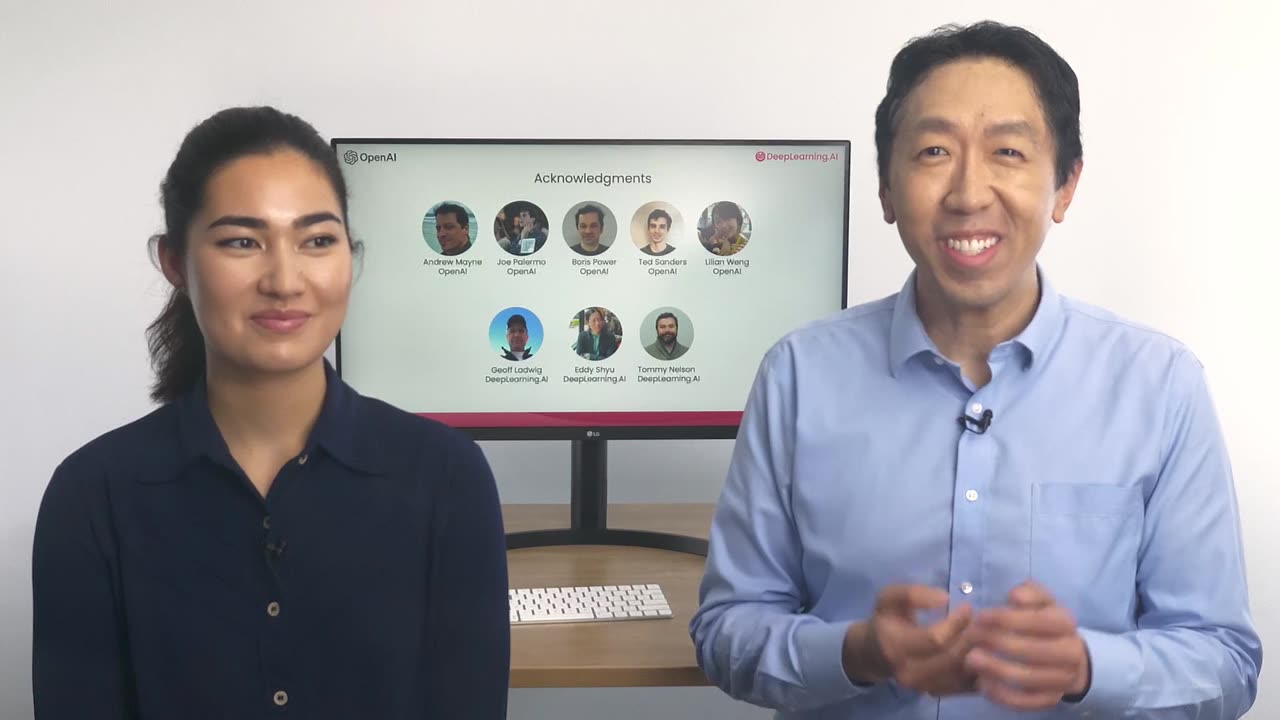Premium Only Content

(Introduction)ChatGPT Prompt Engineering for Developers
Welcome to this course on ChatGPT Prompt Engineering for Developers.
I'm thrilled to have with me Isa Fulford to
teach this along with me. She is a member of
the technical staff of OpenAI and had built
the popular ChatGPT Retrieval plugin and a large
part of her work has been teaching people
how to use LLM or Large Language Model
technology in products. She's also contributed to the OpenAI Cookbook that
teaches people prompting. So thrilled
to have you with me.
And I'm thrilled to be here and share some prompting
best practices with you all.
So, there's been a lot of material on the internet
for prompting with articles like 30 prompts everyone
has to know. A lot of that has been focused on the
chatGPT web user interface, which many people are using to
do specific and often one-off tasks. But, I think
the power of LLMs, large language models, as a
developer tool, that is using API calls to LLMs to quickly build
software applications, I think that is still very underappreciated.
In fact, my team at AI Fund, which is a sister company to
DeepLearning.ai, has been working with many startups on
applying these technologies to many different
applications, and it's been exciting to see what LLM APIs
can enable developers to very quickly build. So, in this
course, we'll share with you some of the
possibilities for what you can do, as well as
best practices for how you can do them.
There's a lot of material to cover. First, you'll learn some prompting best
practices for software development, then we'll cover some
common use cases, summarizing, inferring, transforming, expanding, and
then you'll build a chatbot
using an LLM. We hope that this will spark your imagination about new
applications that you can build.
So in the development of large language models or LLMs,
there have been broadly two types of LLMs, which I'm
going to refer to as base LLMs and instruction-tuned LLMs.
So, base LLM has been trained to predict
the next word based on text training data, often trained
on a large amount of data from the
internet and other sources to figure out what's the next
most likely word to follow. So, for example, if you were to prompt us once
upon a time there was a unicorn, it may complete
this, that is it may predict the next several words are that
live in a magical forest with all unicorn
friends.
But if you were to prompt us with what is the capital of France,
then based on what articles on the internet might have, it's
quite possible that the base LLM will complete
this with what is France's largest city, what is France's population and
so on, because articles on the internet could
quite plausibly be lists of quiz questions about the
country of France.
In contrast, an instruction-tuned LLM, which is where a lot of
momentum of LLM research and practice has been going, an
instruction-tuned LLM has been trained to follow instructions. So, if you
were to ask it what is the capital of France, it's much more
likely to output something like, the capital of
France is Paris. So the way that instruction-tuned LLMs are typically
trained is you start off with a base
LLM that's been trained on a huge amount of text data and further train
it, further fine-tune it with inputs and outputs that are instructions
and good attempts to follow those
instructions, and then often further refine using a technique called
RLHF, reinforcement learning from human feedback, to
make the system better able to be helpful and
follow instructions. Because instruction-tuned LLMs have been trained
to be helpful, honest, and harmless,
so for example, they are less likely to output problematic
text such as toxic outputs compared to base
LLM, a lot of the practical usage scenarios have been shifting toward
instruction-tuned LLMs. Some of the best practices you
find on the internet may be more suited for a
base LLM, but for most practical applications today, we would
recommend most people instead focus on
instruction-tuned LLMs which are easier to
use and also, because of the work
of OpenAI and other LLM companies becoming safer and more aligned.
So, this course will focus on best practices for instruction-tuned
LLMs, which is what we recommend you use for most
of your applications. Before moving on, I just want to
acknowledge the team from OpenAI and DeepLearning.ai that
had contributed to the materials that Isa and
I will be presenting. I'm very grateful to Andrew Mayne, Joe Palermo, Boris
Power, Ted Sanders, and Lillian Weng from OpenAI that
were very involved with us brainstorming materials, vetting the materials
to put together the curriculum for this short
course, and I'm also grateful on the DeepLearning side for
the work of Geoff Lodwig, Eddy Shyu and Tommy
Nelson. So, when you use an instruction-tuned LLM, think of giving
instructions to another person, say someone that's smart but
doesn't know the specifics of your task. So, when an LLM doesn't work, sometimes
it's because the instructions weren't clear enough. For example,
if you were to say, please write me something about
Alan Turing. Well, in addition to that, it can be helpful to be
clear about whether you want the text to focus on his scientific
work or his personal life or his role
in history or something else. And if you
specify what you want the tone of
the text to be, should it take on the tone like a
professional journalist would write. Or is it more of a
casual note that you dash off to a friend?
That helps the LLM generate what you want. And of
course, if you picture yourself asking, say, a
fresh college graduate to carry out this task for
you, if you can even specify what snippets of text, they
should read in advance to write this text about
Alan Turing, then that even better sets up
that fresh college grad for success to carry
out this task for you. So, in the
next video, you see examples of how to be clear and specific,
which is an important principle of prompting LLMs. And you
also learn from Isa a second principle of
prompting that is giving the LLM time to
think. So with that, let's go on to the next video.
-
 2:17:31
2:17:31
Laura Loomer
4 hours agoEP117: GOP Lets Radical Muslims Take Over Texas
21.3K42 -
 DVR
DVR
SpartakusLIVE
7 hours agoDuos w/ GloryJean on VERDANSK || #1 Most EATING Streamer
40.6K1 -
 7:25:28
7:25:28
Spartan (Pro Halo esports Player)
9 hours agoSdcrims no comms, then College match
45K -
 34:43
34:43
Stephen Gardner
6 hours ago🚨Trump Lawyer makes TWO HUGE ANNOUNCEMENTS | Benny Johnson
68.5K46 -
 2:17:31
2:17:31
Robert Gouveia
7 hours agoJudge BLOCKS Proof-of-Citizenship! Trump BACK to Supreme Court! Deportee Discovery STAYED!
66.9K29 -
 7:04:37
7:04:37
MyronGainesX
21 hours ago $18.00 earnedCollege Debate Reaction, Jordan Peterson Sells Out, Shannon Sharpe Shakedown!
97.9K30 -
 2:01:49
2:01:49
Joker Effect
4 hours agoWE ARE IN THE WILDWEST! Frontier Legends is crazy!
17.2K -
 3:54:43
3:54:43
FrizzleMcDizzle
5 hours agoELDEN RING and I'm officially a creator on RUMBLE
21.8K -
 1:33:35
1:33:35
theoriginalmarkz
7 hours agoEvening News with MarkZ, joined by Jonathan Otto. 04/24/2025
73.7K6 -
 LIVE
LIVE
Lilpaul112
7 hours agoSolos On the Island / Repo Time With the Brrrap Pack Gang!
82 watching